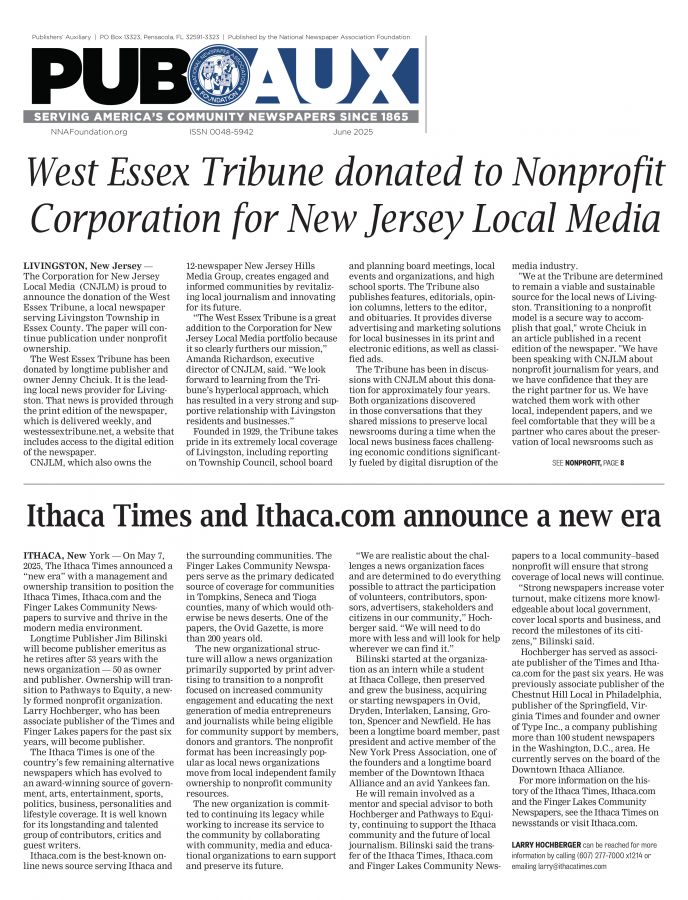Survey: Community newspaper circulation steady, increases
May 2, 2012
By Stanley Schwartz
In the past 10 years, community newspaper circulation has remained steady or increased at the majority of publications—46 percent—that answered a recent survey.
The informal survey, done by the National Newspaper Association, asked association members to respond to questions about their circulation operations.
At least 11.3 percent of the respondents said they have seen an increase in circulation of more than 5 percent in the past 10 years. And 34.8 percent said their circulation remained steady.
On the other side, nearly 41 percent have seen a decline of more than 5 percent.
Of those that saw a decline, the majority of them, 71, percent, said it was because of the general economic decline. Next on the list of reasons was the aging population, 42.2 percent, and the third reason for circulation decline was competition from the publication’s own Internet or digital products—32.5 percent. Many of the respondents mentioned poor postal delivery to out-of-county subscribers as a major reason for their loss of circulation.
For those publications that saw an increase in circulation, more than half, 52.2 percent, attributed the rise to improved news coverage. More than 40 percent said aggressive marketing helped improve their circulation.
One respondent said regular research helps the paper spot trends of which it can take advantage. Also, its website’s growth allows the company to cross promote its products. NNA sponsored readership studies the last five years through the Reynolds Journalism Institute. Results of those studies are available to NNA members on the association’s website—www.nnaweb.org.
Even though newspapers have generally been skeptical of their websites, the majority of those surveyed, 70 percent, said they use their online resources to help build circulation. Only 26 percent still use in-house telemarketing. And 14 percent said they use a telemarketing vendor.
Putting up a paywall on the website helped one newspaper increase it’s paid circulation. Making it easy for people to buy subscriptions online was another reason for its increase.
One paper works with youth organizations to help sell subscriptions, though the children no longer go door-to-door because of safety concerns. Of those respondents that use charity groups to help sell subscriptions, half say they offer the groups a flat rate to compensate them.
Many publications delivered through the mail, currently use circulation software to get the best postage rates. Nearly half of those surveyed, 45 percent, use Interlink. Most of them, 77 percent, say they plan on staying with their current circulation software vendor. Six percent say they will be making a change soon. A respondent said the reason for wanting to make a change is the need for a walk-sequencing option.
NNA helped secure a discount that allows newspapers to claim a discount for up to 5,000 copies per issue for outside county circulation, provided those publications have some in-county circulation.
Of those who answered the question, 46.3 percent said this discount helped save on their postal costs.
The majority of survey respondents, 97 percent, say they use U.S. Postal Service to deliver their papers. At least 75 percent of them also sell their papers in stores, and 73 percent sell single copies through news vending machines. In some small and mid-size communities, people still show up at the newspaper’s office to get their paper. At least 42 percent of the respondents said they have local people coming to the front counter for their paper, when it’s fresh off the press.
Reminding subscribers that their subscriptions are about to expire is an important part of maintaining circulation and reducing churn. Of those surveyed, 68 percent said they send renewal notices by First Class Mail. Only 7 percent insert the renewal in the paper. Some, 17 percent, use automatic renewal by credit card. One paper uses post card renewal notices, but noted that the third notice goes out First Class with a self-addressed return envelope included.
Interestingly, of those who responded to the survey question on distribution methods, 13 percent said that in the past five years they have moved from mailed delivery to home delivery, though an equal number have moved from home delivery to mailed delivery. Only about 8 percent of this segment has discarded their print editions entirely, going to online-only distribution.







